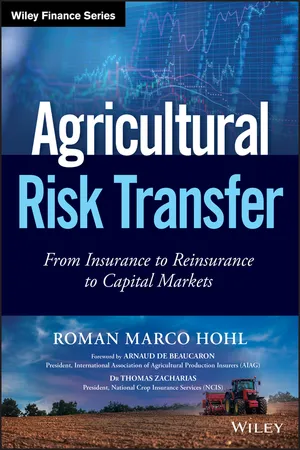
Agricultural Risk Transfer
From Insurance to Reinsurance to Capital Markets
- English
- ePUB (mobile friendly)
- Available on iOS & Android
About This Book
Gain a holistic view of agricultural (re)insurance and capital market risk transfer
Increasing agricultural production and food security remain key challenges for mankind. In order to meet global food demand, the Food and Agriculture Organisation estimates that production has to increase by 50% by 2050 and requires large investments. Agricultural insurance and financial instruments have been an integral part to advancing productivity and are becoming more important in increasingly globalized and specialized agricultural supply chains in the wake of potentially more frequent and severe natural disasters in today's key producing markets.
Underwriting, pricing and transferring agricultural risks is complex and requires a solid understanding of the production system, exposure, perils and the most suitable products, which vastly differ among developed and developing markets. In the last decade, new insurance schemes in emerging agricultural markets have greatly contributed to the large growth of the industry from a premium volume of US$10.1 billion (2006) to US$30.7 billion (2017). This growth is bound to continue as insurance penetration and exposure increase and new schemes are being developed. Agricultural (re)insurance has become a cornerstone of sovereign disaster risk financing frameworks.
Agricultural Risk Transfer introduces the main concepts of agricultural (re)insurance and capital market risk transfer that are discussed through industry case studies. It also discusses best industry practices for all main insurance products for crop, livestock, aquaculture and forestry risks including risk assessment, underwriting, pricing, modelling and loss adjustment.
- Describes agricultural production risks and risk management approaches
- Covers risk transfer of production and financial risks through insurance and financial instruments
- Introduces modelling concepts for the main perils and key data sources that support risk transfer through indemnity- and index-based products
- Describes risk pricing and underwriting approaches for crop, livestock, aquaculture and forestry exposure in developed and developing agricultural systems
- Become familiar with risk transfer concepts to reinsurance and capital markets
- Get to know the current market landscape and main risk transfer products for individual producers, agribusinesses and governments through theory and comprehensive industry case studies
Through Agricultural Risk Transfer, you'll gain a holistic view of agricultural (re)insurance and capital market solutions which will support better underwriting, more structured product development and improved risk transfer.
Frequently asked questions
CHAPTER 1
Agricultural Markets and Risk Management
1.1 INTRODUCTION
1.2 TRENDS AND CHALLENGES IN THE AGRICULTURAL SECTOR
RISING DEMAND
CHALLENGED SUPPLIES
Structural Changes
Table of contents
- Cover
- Table of Contents
- Foreword
- Introduction
- Acknowledgements
- Special Thanks
- CHAPTER 1: Agricultural Markets and Risk Management
- CHAPTER 2: Concepts of Insurance
- CHAPTER 3: Agricultural Perils and Risk Modelling Concepts
- CHAPTER 4: Agricultural Data and Proxies
- CHAPTER 5: Agricultural Insurance
- CHAPTER 6: Crop Insurance
- CHAPTER 7: Livestock Insurance
- CHAPTER 8: Aquaculture Insurance
- CHAPTER 9: Forest Insurance
- CHAPTER 10: Risk Transfer to Reinsurance Markets
- CHAPTER 11: Risk Transfer to Capital Markets
- Acronyms and Abbreviations
- Index
- End User License Agreement